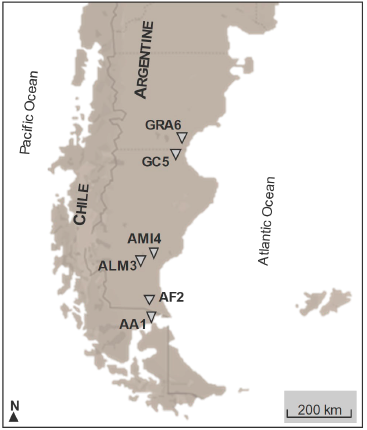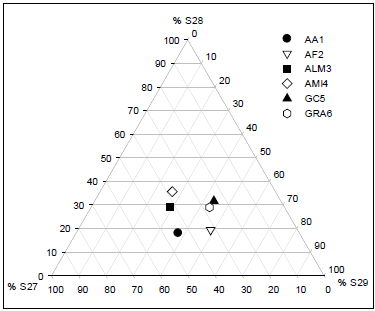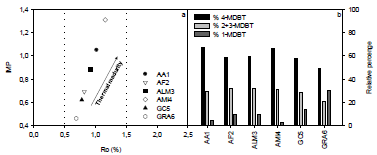1. Introduction
Biomarkers are useful to establish the correlation between the crude oil and the original conditions in the source rock such as animal, vegetable, fungus, protozoa, bacterial organic matter. Additionally, biomarkers are useful to determine the thermal maturity of petroleum, or to evaluate migration and the degree of biodegradation based on the loss of alkanes, isoprenoid, aromatic compounds, terpanes and steranes. A specific composition will also aids to understand the migration patterns, to determine the environmental conditions of deposition, and even to know the age of the source rock in geological terms (eons) [1]. Mulabagal et al. (2013) [2] described biomarkers as complex molecules present in oil that are characterized by high stability during the stages that originated crude oil (diagenesis, catagenesis and metagenesis). This property is inherent to the characteristics chemical structure of specific molecules, so they can withstand the high pressures and temperatures generated in the source rock without undergoing major modifications, allowing them to correlate with their biogenic precursors (terpenoids and steroids). The most commonly studied biomarkers are pristane (Pr) and phytane (Ph) due to their high abundance in oil samples [1]. Both of them are alicyclic diterpanes derived from the phytol molecule associated with the chlorophyll structure, and they are crucial to determine crude biodegradability in short periods of time. Two other groups of biomarkers include steranes and hopanes. The presence of hopanes in an oil sample is indicative of an important contribution of hopanoid acids coming from bacteria [3]. Among these biomarkers, the presence of C27 18α (H)-22, 29, 30-trisnorneohopano (Ts), which is thermally more stable than C27 17α (H)-trisnorhopane (Tm), is used to predict the thermal evolution of crude oils [4]. Geochemical studies also include the detection and quantification of aromatic markers that complement the information provided by biomarkers. Methylphenantrenes have been used as maturity parameters and are experimentally correlated with vitrinite reflectance (Ro) [5].
Argentinean south Patagonia is characterized by the presence of two main hydrocarbon basins: the Golfo San Jorge basin (GSJB) and Austral basin (AB) [6]. The GSJB is located between the south of Chubut province and the north of Santa Cruz province. The wells of the north flank show lack of structural closures and absence of mother rock with generation capacity, while the wells of the south flank exhibit poor reservoir conditions and limited lateral development. The river sandstones of the Bajo Barreal formation comprise the main reservoir, which is well developed towards the land sector, as well as the area of maturation of generating rock. In addition, the levels of tuffs and sandy tuffs from the Castillo formation underlie this unit, and due to its poor petrophysical properties, the quality of the reservoir is poor. Although hydrocarbons are likely to be present in shallow prospects, the risk is associated with migration of hydrocarbons to the reservoir and to the system of failures that control the entrapment of oil. The deep leaflet model has the best exploration potential, but the risk is greater with drilling depths of up to 4000-5000 m, and gas is more likely to be discovered [7].
The AB contains four main geological formations. The Inferior Inoceramus formation, mainly composed of shale rich in organic matter; the Margas Verdes formation mainly composed of shale from marine origin; the Lower Magellan (Paleocene-Eocene) composed of glauconitic and quartz sandstones and lutites (deposited in a marine environment); and the Upper Magellan (Eocene-Miocene) composed of conglomerates, sandstones, lutites and lignite beds. Studies conducted by Villar et al. in 1993 [6] on crude oils in the Esperanza region (in the middle of the basin) made an important description of kerogen type, sedimentation environment, lithology and thermal maturity based on organic matter microscopic observations, hydrocarbon profiles and biomarkers. This report provided evidence to justify a deep study of this area, source rock and crude oils produced in this basin relying only on the analysis of biomarkers and aromatic compounds [6].
In this work, we provide details on the geochemical characteristics of the Austral and the Golfo San Jorge basins after the characterization of crude oil samples. Biomarkers such as Pr, Ph, Hopanes, Steranes and aromatic markers were used to investigate certain aspects of crudes as organic matter precursor, the deposition environment, the lithology of the source rock and thermal evolution [8]. The results obtained allowed for the first comprehensive description based on biomarkers of the thermal maturity, organic matter, sedimentological environment and lithology of the source rock, in oil samples from AB and GSJB.
2. Materials and methods
2.1 Crude oil samples
Oil samples were obtained from four sites (AA1, AF2, ALM3 and AMI4) located in the AB, and from two sites (GC5 and GRA6) belonging to the GSJB (Fig. 1). They were collected directly from the oil-producing wells and transported to the laboratory. These were received in clean, caramel-colored one-litre bottles to avoid photo-oxidation. The presence of an air headspace was avoided to minimize the impact of oxygen on the stability of the samples. Bottles were stored in dark and dry places at room temperature until analyses within 72 hours of taking the samples.
2.2 Conditioning of oil samples
Approximately 100 µL of petroleum were diluted in 10 mL of pentane, and cleaned up by using a silica gel slurry, filterer using Wathman 1 paper, and transferred to vials for chromatography. Additionally, 100 µL of petroleum were subjected to a column separation into aliphatic and aromatic fractions by passing through a silica gel column (20 cm x 1.2 cm). For this, a glass column packed with 3 g of activated silica gel (105°C, 24 hs) was used, followed by 50 mm of activated Na2SO4 and 50 mm of activated alumina in the upper part. The hydrocarbon mixture was then eluted with 10 mL of n-pentane and 10 mL of dichloromethane to obtain the aliphatic and aromatic fractions, respectively. Both extracts were separately concentrated up to 0.5 mL under nitrogen and transferred to a chromatography vial. The three prepared extracts were stored at -15 °C until analysis [9].
2.3 Chromatographic analysis
One microliter of each crude oil sample was injected in split mode with a ratio of 1:10 into a gas chromatograph, while the aliphatic and aromatic fractions were injected in splitless mode. The chromatographic separation was conducted in a gas chromatograph Agilent model 7890A, with detector by mass spectrometry of the same brand model 5975C. A 30 m long HP5ms column was used, with an internal diameter of 0.32 mm and a film thickness of 0.25 μm. The injector temperature was set at 290°C and helium was used as the carrier gas with a flow rate of 1.2 mL/min. The temperature ramp used was as follows: initial temperature of 55°C during 2 min, ramp from 6°C/min to 270 °C, going directly to another ramp of 3 °C/min until reaching 300 °C, remaining at this temperature for 17 min. The total running time was approximately 65 min. The mass detector was used with an ion source and transfer line temperature of 230°C and 180°C respectively and an impact energy of 70 eV. The mass scan between 29 and 400 uma was performed in Scan mode to analyze the extracts of petroleum and the aromatic fraction, and in SIM mode for the ions 191 and 217 for the extract of the aliphatic fraction [10].
3. Results and discussion
3.1 Precursor organic matter
Tricyclic Terpanes and Hopanes are considered to be the most important components of petroleum to determine the origin of the precursor organic matter of crude oil since they better conserve the structure of the biological components from which they are produced [11]. Hopanoids are biological precursors related to the cell membrane of prokaryotes [12]. The distribution of hopanes and tricyclic terpanes shows a disparity between crude oil samples in terms of precursor organic matter (Fig. 2). GC5 and GRA6 exhibit a higher relative proportion of tricyclic terpene T23 compared with T24 and hopane H30, which are mainly associated with the nature of precursor organic matter, in this case from marine environments [3]. On the other hand, in AA1, AF2, ALM3 and AMI4, the hopane H30 is the predominant component inferring a more significant contribution of terrestrial organic matter [12]. In addition, it is interesting to note that oleanane was not identified in any of the chromatograms, which indicates that there was no contribution of organic matter from land plants and might relate the origin to a geological time before the Cenozoic [1].
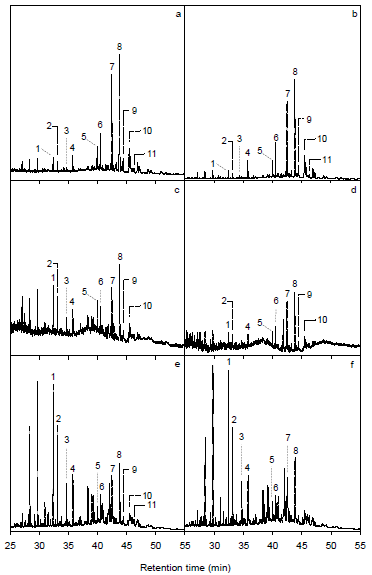
Source: Authors’ own elaboration.
Figure 2 Fragmentograms for ion m/z 191 for samples AA1 (a), AF2 (b), ALM3 (c), AMI4 (d), GC5 (e) and GRA6 (f). On the ordinate axis, the "relative abundance" is observed, and on the abscissa axis the "retention time (min)" is presented. The compounds marked with numbers are: 1 tricyclic terpane (T23), 2 tricyclic terpane (T24), 3 tricyclic terpane (T25), 4 tricyclic terpane (T26), 5 trisnorneohopane (Ts), 6 trisnorhopane (Tm), 7 norhopane (H29), 8 hopane (H30), 9 moretane (M30), 10 homohopane (H31) and 11 gammacerane (G30).
Steranes also provide information on the precursor organic matter; the relative proportions between S27, S28 and S29 steranes suggest the presence of algal or terrestrial type matter [13]. For AA1, ALM3 and AMI4, the most important type of organic matter is algal due to the predominance of sterane S27. In the case of AF2, GC5 and GRA6 the sum of S27 + S28 exceeds S29; these compounds are associated with the presence of red, green and zooplankton algae, so their origin would be mainly marine with a significant contribution of terrestrial/coastal organic matter [3]. This characteristic deserves further investigation since sterane S29 is not exclusive to land pants and can be found in some types of algae (Fig. 3) [14].
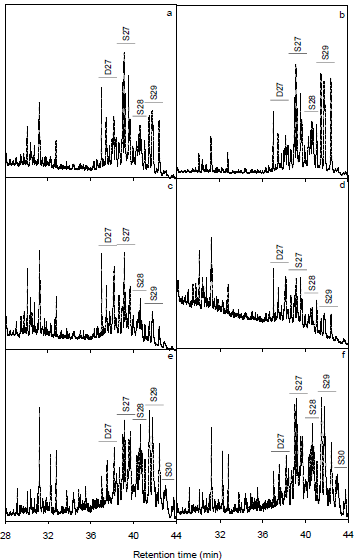
Source: Authors’ own elaboration.
Figure 3 Fragmentograms for ion m/z 217 for samples AA1 (a), AF2 (b), ALM3 (c), AMI4 (d), GC5 (e) and GRA6 (f). On the ordinate axis, the "relative abundance" is observed and on the abscissa axis, the "retention time (min)" is presened. The compounds listed are D27 (diasteranes), S27 (cholestanes), S28 (ergostanes), S29 (stigmastanes) and S30 (methylesteranes).
Pristane and phytane are the most important isoprenoids due to the concentration in which they are found in crude samples. The relationship between these (Pr/Ph) and the one obtained from them with their normal alkanes, heptadecane (n-C17) and octadecane (n-C18), provides relevant information [15]. Table 1 and Fig. 4 show that the crude oils AF2, GC5 and GRA6 have a Pr/Ph ratio around 1, suggesting that the origin of the organic matter is predominantly marine [16]. In the case of samples AA1, ALM3 and AMI4 a value around 2 indicates that the origin of organic matter is marine with some contribution of terrestrial type matter [17]. The correlation between the diagnostic rates Pr/n-C17 vs Ph/n-C18 (Fig. 5b) showed that AF2, GC5 and GRA6 have a predominant contribution of organic matter Type II from marine environments. AA1, ALM3 and AMI4 are found in the Type II-III zone, suggesting an important contribution of terrestrial organic matter for these crudes [1].
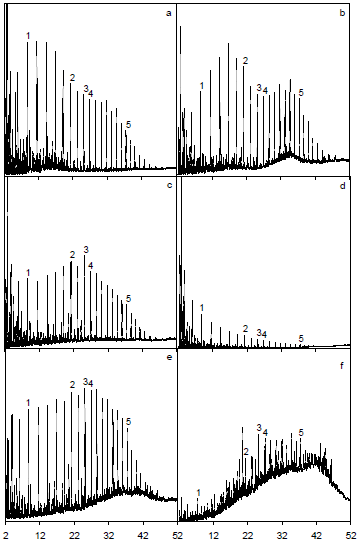
Source: Authors’ own elaboration.
Figure 4 TIC for samples AA1 (a), AF2 (b), ALM3 (c), AMI4 (d), GC5 (e) and GRA6 (f). In the ordinate axis, the "relative abundance" is observed and in the abscissa axis, the "retention time (min)" is presented. The compounds marked with numbers are 1 (hexadecane), 2 (pentadecane), 3 (heptadecane), 4 (octadecane) and 5 (pentacosane).
3.2 Deposition environment and lithology
The Pr/Ph ratio is an important parameter to establish a possible deposition environment in which the organic matter sedimented [18]. By analyzing Fig. 5a, it can be noticed that the GRA6 sample has a value of Pr/Ph < 1. This suggests moderately anoxic conditions favoring the formation of phytane over pristane [13]. According to the Pr/Ph ratios, GC5 and AF2 (1 < Pr/Ph < 3) are related to suboxic environments, which is very close to anoxic, while the rest of the crudes (AA1, ALM3 and AMI4) are in a marked zone of suboxicity. This description is supported by the Shanmugan Diagram (Fig. 5b) as GRA6 appears in a strongly reducing area, GC5 and AF2 in a moderately reducing area and the other three are slightly reducing. It is important to note that relationships based on these isoprenoids and their corresponding alkanes may be affected by the level of thermal maturity of the kerogen, different sources of organic matter, co-elution of other isoprenoids with the same retention time and for primary migration effects during the preferential expulsion of n-alkanes versus isoprenoids [12].
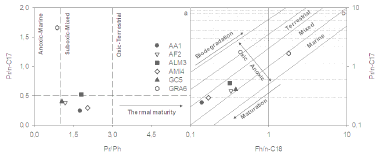
Source: Authors’ own elaboration.
Figure 5 Pr/n-C17 ratio as a function of Pr/Ph ratio obtained from TIC (a) and Shanmugan Diagram (b) for crude oils. Pr: pristane, Ph: phytane, n-C17: heptadecane, n-C18: octadecane.
When determining the sedimentation environment, hopanes H29 and H30 should be taken into account as they are dominant terpanes in most geological samples with a H29/H30 ratio around 0.5 [16]. However, if the concentrations are very high, this is usually associated with carbonate facies rich in organic matter [13]. That is why this ratio is used to indicate the carbonate character of the sedimentation environment in such a way that when it is higher than one, it is considered to be predominantly carbonate [19]. Table 1 suggests that GC5 and GRA6 samples come from a parent rock with carbonate facies (H29/H30 > 1), for the rest, the siliciclastic character is more pronounced as its values oscillate around 0.8. Another indicator to take into account is the one resulting from the relationship between the Gammacerane and the Hopane H30 (Table 1): the higher the value of this parameter, the greater the carbon character. As it can be noticed, the presence of Gammacerane is higher for GC5 and GRA6, which is consistent with results for H29 [20].
Table 1 Geochemical information from the crude oil samples studied. Pr: pristane, Ph: phytane, n-C17: heptadecane, n-C18: octadecane, T23: tricyclic terpane, T24: tricyclic terpane, T25: tricyclic terpane, T26: tricyclic terpane, H29: norhopane, H30: hopane, G30: gammacerane, S27: cholestane, S28: ergostane, S29: stigmastane, D27: diasterane, Ro: vitrinite reflectance, IMP: methylphenanthrene index, MDTP: methyldibenzothiophene.
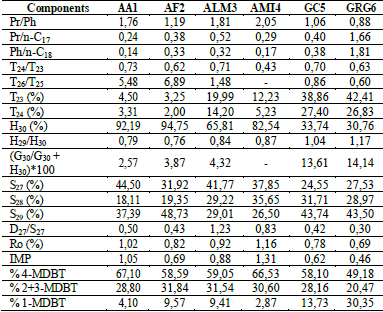
Source: Authors’ own elaboration.
From the ratio between T26/T25 and T24/T23 (Fig. 6a), it is possible to define whether the lithology of the parent rock is marine or lacustrine and carbonate or shale type [21]. The data obtained for these relationships in the samples are presented in Table 1 and Fig. 6.
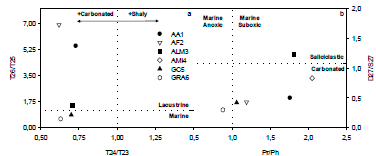
Source: Authors’ own elaboration
Figure 6 T26/T25 vs T24/T23 to determine the lithology of the parent rock and the deposition environment from ion m/z 191 (a) and ratio D27/S27 as a function of the Pr/Ph ratio obtained from TIC and ion m/z 217 respectively (b). Pr: pristane, Ph: phytane, T23: C23 tricyclic terpane, T24: C24 tricyclic terpane, T25: C25 tricyclic terpane, T26: C26 tricyclic terpane, D27: diasterane, S27: cholestane.
Samples GC5 and GRA6 group together due to the marine environment and the lithology of the carbonatic parent rock. This is in line with anoxic environments suggested by Pr/Ph and with the presence of Gammacerane and Hopane H29. A second group (AA1, AF2 and ALM3) has a carbonate bedrock in a lacustrine environment; this is adjusted to suboxic environments, low concentration of Gammacerane and H29/H30 < 1. All samples are characterized by a high presence of tricyclic terpene T23 with respect to T24 (Fig. 2); this qualitatively makes the T23/T24 ratio to be high. However, in the case of terpanes T28 and T29, there is a marked difference between them, since GC5 and GRA6 (Fig. 2) displayed high concentrations. Based on the biomarkers analysis of these crudes, we can therefore suggest that the lithology of the GSJB would contain a carbonate-type generating rock.
The presence of bisnorhopane (BNH28) in AMI4, GC5 and GRA6 samples suggests a reducing environment [5]. The D27/S27 diagnostic ratio is an indicator of the sedimentation environment and the type of lithology of the parent rock [16]. Fig. 6b shows how GRA6 and GC5 belonging to the same basin stand out for their greater preponderance of an anoxic environment and a carbonate type generating rock. Close to these is AF2, in which a more siliciclastic lithology is observed and an environment with a greater presence of oxygen. In the case of AA1, ALM3 and AMI4 located to the upper right of the graph, the environment becomes suboxic and with a greater siliciclastic contribution. The relationship between the relative percentages of S27, S28 and S29 can be represented by Fig. 7, which is based on the ternary diagram proposed by Moldowan et al. (1985). It allows to visualize that ALM3 and AMI4 are associated to lithology of the marine-type lutites and source rocks of carbonate-type. GC5, GRA6, AA1 and AF2 to carbonate-type source rocks [8].
3.3 Thermal maturity
Fig. 5a depicts an increase in thermal maturity as a function of increased Pr/Ph ratio. GRA6, GC5 and AF2 are located on the left with a short distance between them. AA1, ALM3 and AMI4 have a higher thermal evolution as they are positioned further to the right. In the Shanmugan diagram (Fig. 5b), maturity grows from the upper right margin to the lower left margin. This graph separates the crudes under study into three main groups. GRA6 with the lowest maturity; GC5, AF2 and ALM3 with intermediate maturity; AA1 and AMI4 with the highest maturity [22]. Another parameter used to determine the level of maturity is the methylphenanthrene index (IMP), which is based on the distribution of methylphenanthrene (MP) and its methylated homologues [23]. Two origins are possible for these compounds derived from steroids and triterpenoids of the biological origin; or originated from methylation reactions of phenanthrene [5]. By comparing the thermostability of the isomers, the 2-MP and 3-MP are the most stable species compared with the 1-MP and 9-MP [24]. Alternatively, Ro (%) is another important parameter to estimate thermal maturity of crude oil [4]. Then, a plot of IMP versus Ro define a series of sectors in the chart that determine the evolution of oils (Fig. 8a). The results from Fig. 8a suggest that all the crudes under study are in the Oil Window, with increasing maturity as follows GRA6, GC5, AF2, ALM3, AA1 and AMI4. This is consistent with the analysis of isomers 1, 2, 3 and 4-methyldibenzothiophene, with increased levels of 2+3 and 4-methyldibenzothiophene in the samples reaching the higher maturities. From Table 1 and Fig. 8b it can be concluded that the GRA6 and GC5 samples display the lowest maturity levels [22].
4. Conclusions
The main results obtained indicate that the all samples are located in the Oil Generation Window. Samples AF2, GC5 and GRA6 are characterized by a contribution of predominant Type II (marine) organic matter, low thermal maturity, a lithology of the parent rock that is carbonate and the deposition environment which is marine in reducing conditions (anoxic). On the other hand, the samples AA1, ALM3 and AMI4 have a marked trait of organic matter type II-III (Mixed), higher sustained thermal evolution and are associated with this the redox conditions are suboxic and the lithology of the parent rock varies between shales and carbonates. Promoting this type of geochemical characterization studies of crude oils, and advancing on the knowledge of the profile biomarkers constitute effective tools not only for the comprehensive characterization of the deposits under study, but also for the development of information that serves as a forensics basis to compare crude oil from different deposits, particularly if they come from different basins.













